Posters
Siblings:
ProceedingsProgrammeProceedingsSpeakersPostersContent PartnersElectrification StageMarkets TheatreR&I ActivitiesStudent DayProgramme Committee & abstracts reviewersPresenters dashboardCome meet the poster presenters to ask them questions and discuss their work
We would like to invite you to come and see the posters at our upcoming conference. The posters will showcase a diverse range of research topics and provide an opportunity for delegates to engage with the authors and learn more about their work. Whether you are a seasoned researcher or simply curious about the latest developments in your field, we believe that the posters will offer something of interest to everyone. So please, join us at the conference and take advantage of this opportunity to learn and engage with your peers in the academic community. We look forward to seeing you there!

PO159: Verification of the Dual Scanning LiDAR wind assessment by using the meteorological observation tower at the Choshi Offshore Wind Power Station.
Yukinari Fukumoto, Chief Technical Manager, Civil Engineering, TEPCO Renewable Power, Inc.
Abstract
In order to obtain the permission for installing an offshore wind power station in Japan, it is necessary to observe the wind speed direction and the wind turbulence intensity for 1 year or more. Therefore, the Dual Scanning LiDAR (DSL) studies about verification of the observation accuracy have been done onshore in Japan. In this presentation, I will show the observation accuracy of DSL by using the meteorological observation tower (met tower) on the sea near the coast of Japan , where is low turbulence intensity which suits the Category C in IEC61400-1. In addition, the observation method that enable to get 3 altitudes wind speeds and turbulence intensities, etc. at the same time as the 10 minutes average. The met tower owned by TEPCO Renewable Power, Inc. is on 3.1km south from the coast of Choshi City, Chiba Prefecture. We observed 10 minutes average wind speeds and turbulences at the 3 altitudes of 40m, 60m and 90m above mean seawater level (MSL), where two light beams from LiDARs on the coast were crossed at. The elevation angles of two light beams on Fixed Mode of the LiDARs were simultaneously changed every 20 seconds . In comparison with 3 cup anemometers and wind vanes of the met tower at MSL40m, 60m and 90m, DSL's 10minutes average wind speeds and directions were in good agreement with those of met tower . And the correlation slope, coefficient of determination and the offset of those values fit the Key Performance Indicators of The Carbon Trust (the KPI). The other hand, turbulence intensities observed by DSL were lower than those by 3 cup anemometers. And the differences were directly proportional to the observation altitudes with a high correlation coefficient. We estimated the differences are caused by the range gate of DSL and the scale of turbulences.







